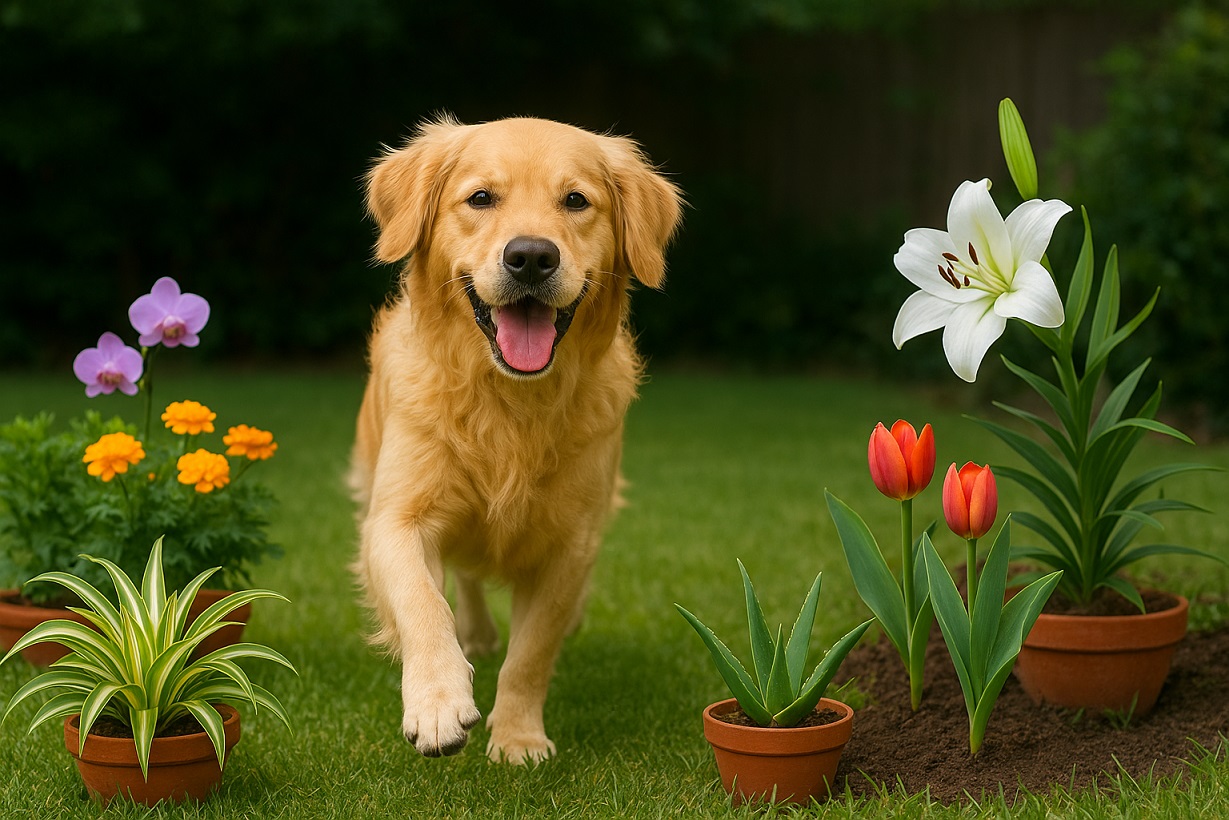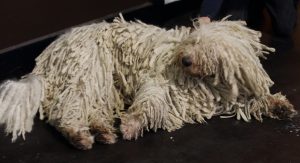Dogs love spending time outdoors, running, playing, and exploring the world with their curious noses. If you have a lawn or garden, it’s likely your dog considers it their favorite playground. Outdoor time not only provides fresh air and exercise but also reduces boredom and anxiety by keeping your dog mentally stimulated.
However, there’s a hidden danger many pet owners overlook: toxic garden plants. While sniffing and nibbling are natural canine behaviors, some common plants can be highly poisonous to dogs, leading to vomiting, seizures, or even death in severe cases.
Before planting or landscaping, it’s essential to know which plants could put your furry friend at risk. Below is a list of popular but dog-toxic plants that should be kept out of your pet’s reach.
Table of Contents
Toxic Plants for Dogs
Aloe Vera:
Aloe Vera is a common household plant known for its healing properties for humans, but it’s toxic for dogs. The leaves contain compounds called saponins and anthraquinones, which can cause vomiting, diarrhea, and lethargy if ingested. If your dog eats any part of the plant, provide fresh water and contact your vet immediately.
Daffodils:
Bright and beautiful, daffodils add cheer to any garden, but they are highly poisonous to dogs. The bulbs are the most toxic part and contain lycorine, a compound that can trigger vomiting, abdominal pain, and irregular heartbeat. Even drinking water from a vase containing daffodils can cause symptoms.
Lily of the Valley:
Despite its delicate, sweet scent, Lily of the Valley is one of the most dangerous garden plants for dogs. It contains cardiac glycosides, which can lead to heart rhythm abnormalities, seizures, and even death if consumed. Keep this plant completely out of your dog’s reach.
Tulips:
Tulips are spring favorites, but their bulbs contain toxins that can cause drooling, vomiting, and depression in dogs. If your pup loves digging in the garden, be cautious; ingestion of tulip bulbs is far more dangerous than leaves or stems.
Sago Palm:
The Sago Palm is beautiful but extremely toxic to both dogs and cats. Every part of the plant, especially the seeds, contains cycasin, which can cause liver failure and death. Even small amounts can be fatal, so avoid planting it altogether if you have pets.
Daisy:
Although daisies look harmless, they contain sesquiterpene lactones, pyrethrins, and other irritants that can cause drooling, vomiting, and skin irritation. While not as deadly as some plants, it’s best to keep your dog from chewing on them.
Foxglove:
Foxglove is a stunning flowering plant often used for ornamental purposes, but it’s also one of the most toxic garden plants for dogs. It also contains cardiac glycosides, the same toxins used in some heart medications, which can cause irregular heartbeat, tremors, and cardiac arrest.
Wisteria:
Wisteria vines may create a gorgeous floral display, but both the pods and seeds are highly poisonous to dogs. Ingesting even small quantities can cause vomiting, diarrhea, and depression. If you have wisteria growing on fences or pergolas, make sure your dog can’t access it.
Tomato Plant:
While ripe tomatoes are generally safe for dogs in small amounts, the green parts of the tomato plant, including stems and leaves, contain solanine, a toxic substance that can lead to weakness, confusion, and digestive upset. Keep curious pups away from your vegetable patch until the fruit is ripe and safe.
Caladium (Elephant Ear)
Caladium plants, also known as Elephant Ear, contain insoluble calcium oxalates that can cause intense burning and irritation in a dog’s mouth. If chewed or swallowed, it may lead to drooling, pawing at the mouth, and vomiting. In severe cases, swelling of the tongue and throat can make it difficult for your dog to breathe.
Hemlock
One of the most dangerous plants for dogs, Hemlock is highly toxic and affects the nervous system. Even a small amount can cause tremors, paralysis, or respiratory failure. Because it looks similar to harmless wild plants like parsley or Queen Anne’s lace, pet owners should be extra cautious on walks and hikes.
Lantana
Lantana’s bright clusters of flowers may look appealing, but they can cause serious harm if eaten by dogs. The plant contains triterpenoids that can lead to vomiting, diarrhea, and liver damage. The berries are particularly toxic, and repeated exposure may result in long-term liver issues.
Sweet Pea (Lathyrus odoratus)
While lovely in gardens, the sweet pea plant can be dangerous for pets. Prolonged ingestion can cause “lathyrism,” a condition that affects a dog’s nervous system and leads to weakness, tremors, and in severe cases, seizures. Fortunately, dogs rarely eat enough to cause serious illness, but prevention is key.
Dumb Cane (Dieffenbachia)
A common indoor plant, Dumb Cane, is known for its large leaves and air-purifying qualities, but it’s toxic to dogs. It contains calcium oxalate crystals that can cause severe mouth irritation, drooling, and swelling of the tongue or throat. If a dog ingests it, they may have trouble swallowing or breathing.
English Ivy (Hedera helix)
English Ivy is popular in gardens and as an indoor vine, but it can be harmful if a dog chews on its leaves or berries. The plant’s triterpenoid saponins can cause vomiting, abdominal pain, and drooling. It’s best to keep this plant out of reach or opt for safer alternatives.
Hosta
Hostas are beloved for their lush, green foliage, but they contain saponins that can upset a dog’s stomach. If eaten, your dog may experience vomiting, diarrhea, and lethargy. While rarely fatal, ingestion can make your pet very uncomfortable and may require veterinary care.
Geranium (Pelargonium)
Geraniums are another popular garden flower that can cause trouble for pets. They contain linalool and geraniol, which can lead to skin irritation, vomiting, and loss of appetite in dogs. If your pet spends time in the garden, it’s best to replace geraniums with safer flowering plants.
Asparagus Fern (Emerald Fern)
Despite its delicate appearance, the Asparagus Fern is toxic to dogs. Its berries and sap can cause skin irritation, vomiting, and diarrhea if ingested. Dogs that repeatedly chew on the plant may develop allergic dermatitis. Keeping it in hanging pots or swapping it for a dog-safe fern is a good precaution.
Autumn Crocus (Colchicum autumnale)
One of the most toxic garden plants, the Autumn Crocus, contains colchicine, which can cause vomiting, diarrhea, kidney failure, and even death. Symptoms may take days to appear, making it especially dangerous. If you suspect your dog has eaten any part of this plant, contact a vet immediately.
Safe Plants for Dogs
Alternatively, you can plant the following plants in your gardens or backyards, as they are totally safe for your dogs.
- Spider Plant: A hardy, non-toxic indoor plant that adds greenery without posing any risk to your furry friend.
- Boston Fern: This lush fern is completely pet-safe and thrives in humid indoor environments.
- Areca Palm: A beautiful, air-purifying palm that’s safe for both dogs and cats.
- Bamboo Palm: Adds tropical charm to your home while being gentle and harmless to pets.
- African Violet: A colorful, dog-safe flowering plant that brightens up any windowsill.
- Blue Echeveria: A stunning succulent that’s safe for dogs and easy to care for.
- Orchid: Elegant and pet-friendly, orchids bring beauty without toxicity concerns.
- Ponytail Palm: A fun, low-maintenance plant that’s perfectly safe for curious dogs.
- Basil: Not only safe but also beneficial, dogs can nibble a leaf or two without harm.
- Marigold: Cheerful and non-toxic, these vibrant blooms are safe for dogs and attract pollinators.
Final Thoughts
Your backyard can be both a fun and safe place for your dog, as long as you know what’s growing there. Regularly check your garden for potentially toxic plants, and replace them with pet-safe alternatives like marigolds, sunflowers, or roses. A little awareness goes a long way in protecting your dog’s health and happiness.










